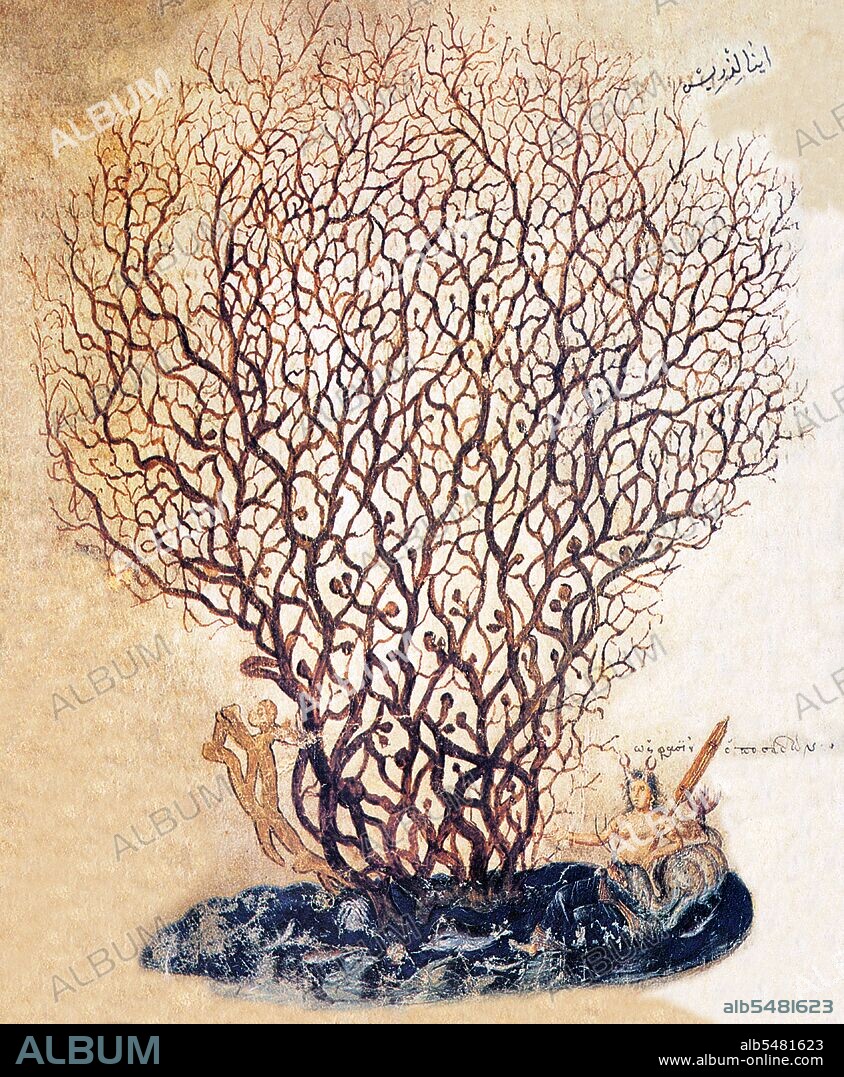alb5481623
Greece-Byzantium-Turkey: An illustration of coral from the Codex Vienna Dioscorides, Constantinople-Istanbul, CE 512. The small figure to the right is the Goddess Thalassa, personification ot the Sea

|
Add to another lightbox |
|
Add to another lightbox |



Title:
Greece-Byzantium-Turkey: An illustration of coral from the Codex Vienna Dioscorides, Constantinople-Istanbul, CE 512. The small figure to the right is the Goddess Thalassa, personification ot the Sea
Caption:
Miniature of a coral from the Carmen de viribus herbarum, a didactic poem on medicinal plants in the Vienna Dioscorides - in ancient times corals were considered to be plants. The Vienna Dioscurides or Vienna Dioscorides is an early 6th century illuminated manuscript of De Materia Medica by Dioscorides in Greek. It is an important and rare example of a late antique scientific text. The 491 vellum folios measure 37 by 30 cm and contain more than 400 pictures of animals and plants, most done in a naturalistic style. In addition to the text by Dioscorides, the manuscript has appended to it the Carmen de herbis attributed to Rufus, a paraphrase of an ornithological treatise by a certain Dionysius, usually identified with Dionysius of Philadelphia, and a paraphrase of Nicander's treatise on the treatment of snake bites. The manuscript was created in about 515 and was made for the Byzantine princess Juliana Anicia, the daughter of Emperor Anicius Olybrius. Although it was originally created as a luxury copy, there is some indication that in later centuries it was used daily as a hospital textbook. It includes some annotations in Arabic. The manuscript was discovered in Istanbul in the 1560s by the Flemish diplomat Ogier Ghiselin de Busbecq who was in the employ of Emperor Ferdinand I. The Emperor bought the manuscript and it is now held in the Österreichische Nationalbibliothek in Vienna. The manuscript was inscribed on UNESCO's Memory of the World Programme Register in 1997 in recognition of its historical significance.
Credit:
Album / Pictures From History/Universal Images Group
Releases:
Model: No - Property: No
Rights questions?
Rights questions?
Image size:
3800 x 4613 px | 50.2 MB
Print size:
32.2 x 39.1 cm | 12.7 x 15.4 in (300 dpi)
Keywords:
ANCIENT WORLD • ANTIGUEDAD • ANTIQUITIES • ANTIQUITY • ART • ARTS • ASIA IMAGE • ASIA PICTURES • ASIA • ASIAN IMAGES • ASIAN PICTURES • ASIAN • BOTANICAL • BOTANIST • BOTANY • BOTANY • BOTANY • BYZANTINE • BYZANTIUM • DIOSCORIDES, PEDANIUS • DOCTOR • GRECO • GREECE • GREEK • GREEKS • HELENICO • HELENISTICO • HELLENIC • HELLENISTIC • HISTORIA UNIVERSAL • HISTORICAL IMAGES • HISTORICAL PICTURES • HISTORICAL • HISTORY IMAGES • HISTORY PICTURES • HISTORY • LEGEND • MATERIA MEDICA • MEDICAL • MEDICO • PAINT • PAINTING • PHARMACOLOGIST • PHARMACOLOGY • PHYSICIAN • TURKEY • TURKISH
 Pinterest
Pinterest Twitter
Twitter Facebook
Facebook Copy link
Copy link Email
Email

